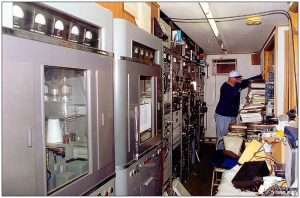NorthEast Radio Watch 12/8/2025: Cichon’s Back in Buffalo
In this week’s issue… Veteran newsman returns - Remembering NY's Leitner, RI's Jones - CT AM saved - Maine AM moves - "Indie" adds suburban signals
In this week’s issue: Remembering top-40’s biggest voice – South Coast loses radio legend – Twilight sells Reading’s WEEU – Big translator sale in Boston
By SCOTT FYBUSH
*The worst thing about writing this column in recent years has been the steady drumbeat of obituaries, and this year has been excruciatingly hard for your editor on a personal level.
In May, there was the sudden death of Bob Bittner, the iconoclastic and fiercely independent proprietor of “The Memories Stations” in New England, and one of your editor’s early mentors in the business.
Now comes an even harder obituary to write, because Clarke Ingram was more than a huge force in top-40 radio. He was a historian of the industry, especially of the DuMont TV network. When he was in his prime, he was a travel whirlwind, an obsessive airchecker, a connoisseur of weird and wonderful small-town radio, a massive physical presence – and for a while, my neighbor here in Rochester, too.
Clarke – his real name, though also one of the all-time great air names (and no relation to Dan Ingram in New York) – was very much a product of Pittsburgh. For decades, his home base remained the small house he grew up in during the 1950s and 1960s. He lost his father at a young age, which drew him close to his mother, Alys, who became a second mother to so many of Clarke’s radio friends over the years.
 Pittsburgh is where his radio career began in the 1970s, graduating from Point Park College into an on-air gig with WXKX (96KX), the top-40 FM sister to venerable WTAE (1250). In those days of top-40 radio wars, he crossed to the other side after a while, programming WBZZ (B94), the other big FM top-40 in town.
Pittsburgh is where his radio career began in the 1970s, graduating from Point Park College into an on-air gig with WXKX (96KX), the top-40 FM sister to venerable WTAE (1250). In those days of top-40 radio wars, he crossed to the other side after a while, programming WBZZ (B94), the other big FM top-40 in town.
He began consulting early on, driving into the hills around Altoona to help launch WBXQ (Q94), shaking up what had been an AM-dominant market with FM top-40. His high-energy delivery was perfect for the “hot hits” era of the 1980s, when he was riding high with Nationwide as PD in Tucson at KKRQ (93.7 KRQ) and in Phoenix at KZZP (104.7); in Tucson, he rung up some of the highest ratings of any top-40 station, ever, as he would happily recount later on.
From there, it was back east, where he based himself in Easton, Pennsylvania to program top-40 at what was WQQQ (Q100), then WHTX (Hot 99.9) – but he was also on the road a lot, jocking in Philadelphia at WEGX/WTRK (Eagle 106/Electric 106) and in New York on WHTZ (Z100).
Our paths crossed during his next big gig, when he came to Rochester to program WPXY (98PXY) as it went through its 1990s bounce among owners and clusters, starting as a standalone under Pyramid Broadcasting and ending up with the Lincoln Group, Clear Channel and CBS Radio. (At various points, he was also programming several sister stations, including an ill-fated attempt to bring WVOR back to its Rochester glory days.)
We became accidental neighbors when your editor moved home in 1997, not realizing the apartment I rented in a hurry was just a few buildings down from Clarke’s; for several years, we were near-daily companions, taking drives as far as West Virginia to go visit small radio stations and record so many hours of cassette airchecks, all labeled in Clarke’s precise printing. He’d recount all the stories of his itinerant radio life, like the time he was in rural northern Pennsylvania dialing around, only to hear a young DJ calling himself “Clarke Ingram.”
The real Ingram couldn’t resist pointing his red Jetta up the mountain to the trailer that housed the studio and transmitter, knocking on the door, meeting “Clarke Ingram” and telling him “hey, that’s me!” (The other “Clarke”? That’s the DJ you now know as Phlash Phelps, and before he became a fixture on SiriusXM’s 60s channel, Clarke ended up hiring him for a while on WPXY.)
 There are so many stories to tell about Clarke: the time he became fascinated by one of America’s last beautiful-music radio stations, a quirky one-man daytimer west of Dayton, Ohio – which is how we ended up road tripping to watch a high school choir concert honoring Stan Coning and watching him keeping the reels turning at WCTM in Eaton (right), for hours and hours and hours. He was a man of enormous appetite, downing multiple milkshakes over a few hours at Friendly’s with his radio buddies, resulting in all those metal milkshake cups turning into models of famous AM directional arrays on an adjoining table.
There are so many stories to tell about Clarke: the time he became fascinated by one of America’s last beautiful-music radio stations, a quirky one-man daytimer west of Dayton, Ohio – which is how we ended up road tripping to watch a high school choir concert honoring Stan Coning and watching him keeping the reels turning at WCTM in Eaton (right), for hours and hours and hours. He was a man of enormous appetite, downing multiple milkshakes over a few hours at Friendly’s with his radio buddies, resulting in all those metal milkshake cups turning into models of famous AM directional arrays on an adjoining table.
He was always, always available to radio people looking to share war stories or looking for a job, which is why social media filled up immediately over the weekend with tales of how jocks got hired based on Clarke’s recommendations. Even those who weren’t ready to be hired somewhere big still got excited to meet Clarke – there’s that random day we were driving through New York’s Southern Tier and stopped at a little trailer in Hornell, where the teenage weekend jock on WKPQ was jumping up and down so hard about meeting the big-city voice she heard on WPXY that I was afraid she’d go right through the floorboards.
Where were we? By the turn of the century, Clarke was back home in Pittsburgh, where a short stint doing jammin’ oldies at “The Beat” WJJJ (104.7) and oldies WWSW (3WS 94.5) became his last stand in commercial conglomerate radio. He then found smaller homes for his vision of how much fun music radio could still be, working for Bob Stevens’ Broadcast Communications stations, where he handled operations and on-air duties for WKFB (770) and WKHB (620), playing high-energy DJ during hours when there was no paid programming.
 Here’s where the story becomes a sad one: beset by health issues of his own and the death of his mother in 2004, he began withdrawing from the radio business, taking one last stab at programming oldies on Ed DeHart’s WZUM (1550) before that station was sold in 2016. By then, his health was already very much in decline as he struggled with diabetes and other ailments, as well as the death in 2014 of his beloved golden retriever, Brinkley.
Here’s where the story becomes a sad one: beset by health issues of his own and the death of his mother in 2004, he began withdrawing from the radio business, taking one last stab at programming oldies on Ed DeHart’s WZUM (1550) before that station was sold in 2016. By then, his health was already very much in decline as he struggled with diabetes and other ailments, as well as the death in 2014 of his beloved golden retriever, Brinkley.
No longer able to travel or even to leave his house when he wasn’t hospitalized, Clarke became very active on social media, filling his Facebook page with TV nostalgia, his strong Christian faith, and above all, motel and restaurant postcards from Route 66, which he’d traveled end-to-end several times while working in Arizona. (His monumental collection of airchecks included hours upon hours of tape of random bits of local radio recorded from the boombox that was always sitting on the passenger seat next to him as he drove; it’s a good bet that there were stations and personalities captured there whose audio existed nowhere else.)
Having been born just as DuMont was winking out of existence, he devoted many hours to studying its history, reaching out to some of the last living veterans of the fourth network as he crafted websites about the network and about the early days of UHF television. (The latter site stays on the web in perpetuity thanks to David Gleason’s World Radio History, thankfully.)
In recent years, even his online existence became sporadic as he bounced between nursing homes and hospitals. As recently as the last year, he tried to launch a new consulting business, running up against the reality of today’s broadcast world.
When he died on Saturday at a Pittsburgh-area rehab facility, Clarke Ingram was just 66.

As we announced a few weeks ago, the 2026 edition of the Tower Site Calendar will be the last.
We began publishing it 25 years ago, and the broadcast landscape is radically different now.
Radio World just ran an excellent article about us if you want to know more.
Once it’s gone, that’s it. We won’t be printing any more.
Thank you to everyone who saw our announcement and rushed to buy it. We appreciate you.
(There are some calendars from previous years if you want more of a tower photo fix — all under $5.)
But don’t wait to get this year’s Tower Site Calendar — buy it now!
We are selling the Broadcast Historian’s Calendar again this year, but we have that in an even smaller quantity — definitely don’t hesitate for that.
And visit the Fybush Media Store to check out our selection of books and videos, too!
In this week’s issue… Veteran newsman returns - Remembering NY's Leitner, RI's Jones - CT AM saved - Maine AM moves - "Indie" adds suburban signals
In this week’s issue… Scripps stations face takeover - Sinclair moves more affiliations - CT stations sold - Maine AM surrendered - Remembering WVBR's Shapiro, WABC's Morgan
In this week’s issue… CT TV legend succumbs to cancer - Remembering PA's Adams - FCC still stalled by shutdown - Pittsburgh morning host exits
In this week’s issue… FCC faces reopening challenges - Veteran Boston anchor retires - Morning shift in Toronto - NYC FMs expand reach